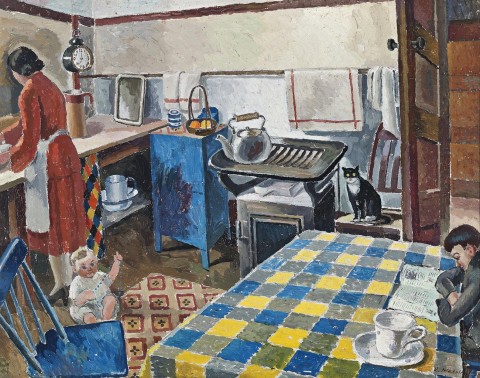THE PAINTER'S FAMILY, EASTER, 1927
ROLAND WAKELIN
oil on pulpboard
43.0 x 55.5 cm
signed and dated lower right: R. Wakelin 1927
Toorak Art Gallery, Melbourne
Ken and Joan Plomley Collection of Modernist Art, Melbourne, acquired from the above in March 1968
Exhibition of Oil Paintings by Roland Wakelin, Macquarie Galleries, Sydney, 22 August – 1 September 1928, cat. 17 (as ‘The Family’)
probably: Exhibition of Mr. Roland Wakelin’s Work: 1913-1930, the residence of Ethel Anderson, Ball Green, Turramurra, 20 – 27 September 1930, cat. 51 (as ‘The Painter’s Family’)
Exhibition of Recent Paintings by Roland Wakelin, Macquarie Galleries, Sydney, 18 August 1937, cat. 50 (as ‘The Family’)
Roland Wakelin Loan Exhibition, Art Gallery of New South Wales, Sydney 14 May – 11 June 1942, cat. 35 (as ‘The Family at Chatswood’) (lent by John Young, Esq.)
Roland Wakelin Retrospective, Art Gallery of New South Wales, Sydney, 8 – 30 April 1967 and touring: Newcastle City Art Gallery, Newcastle, 10 – 13 May 1967, cat. 31 (as ‘The Painter’s Family (Easter 1927)) (label attached verso) (lent by Roland Wakelin)
The Artist's Family, c.1928, oil on board, 50.5 x 61.0 cm, private collection
Sewing machine, 1928, oil on composition board, 59.8 x 90.1 cm, in the collection of Geelong Art Gallery, Victoria
By 1927, when this delightful painting was created, Roland Wakelin was one of Australia’s leading modernists. He had already achieved considerable notoriety in 1919 when, with his art school colleague Roi de Mestre (later Roy de Maistre), he mounted the landmark exhibition Colour in Art at Gayfield Shaw’s gallery in Sydney. He followed this with an intense period of study under Max Meldrum before travelling to Europe between 1922 and 1924. On his return, Wakelin’s family and local environs increasingly became the subject matter of his paintings and in The Painter’s Family, Easter, 1927, he captures the intimacy of their kitchen in Johnston Street, Chatswood, occupied by his wife Estelle, son Roland Jnr, the ten-month old baby Judith, and Weedy, the cat. This was one of the many houses and flats which the family lived in near to Sydney Harbour, and indeed, by the time Judith was fifteen, she had already lived in twelve different places.1
Although he came later to discount the ‘colour-music’ theories developed with de Maistre, there is no doubt that this period ‘was influential upon Wakelin’s visual expression long after he consciously abandoned these ideas. Colour remained the most enduring quality in his paintings using it intuitively rather than following a formulaic method’.2 The time spent studying with Max Meldrum was also influential as he championed his own controversial theory of the ‘science of appearances’, which was based on a close scrutiny of tonality and light. During Wakelin’s journey to Europe, he was able to see firsthand the work of master artists, such as Van Gogh, whose paintings he had only known previously via monochromatic reproductions.3 All of these inspirations found fruition in Wakelin’s capable hands and on his return to Australia, he determined to follow his own path focusing on family life. Here, he found inspiration in ‘the ordinary, [passing such subjects] through the refining fire of his creative processes so that they emerge on canvas as images in which the ordinariness has been transformed by a quiet but unmistakable dignity’.4
Whilst in London, Wakelin’s friend, the framer John Young, was also there with his family, and the two men would meet weekly to explore galleries together. After his return, Young partnered with the critic Basil Burdett to open the highly influential Macquarie Galleries in Bligh Street, Sydney, and Wakelin was invited to mount the inaugural show. In the catalogue introduction, Margaret Preston wrote: ‘Roland Wakelin is a modern … (His work) is personal and thoughtful, full of aesthetic qualities; above all introspective, and characterised by a fine colour sense’.5 She also bought one of the exhibited works. The Painter’s Family, Easter was included in Wakelin’s second exhibition at Macquarie in 1928 (he held more than twenty with them during his life), a collection which featured companion scenes drawn from the nearby locales of Ball’s Head, Berry’s Bay, Kerosene Bay and North Sydney. In related paintings, the domesticity celebrated in The Painter’s Family, Easter, is echoed in The Artist's Family, c.1928 (private collection), and the engaging black-and-white Weedy takes central position in Cat in the Window, c.1929 (private collection), peering out from the Wakelin’s next family residence in Edward Street, North Sydney.
1. See Murray, L., ‘Selected works by Roland Wakelin from the Estate of the artist’s daughter, Judith Murray, Sydney’, Deutscher and Hackett, November 2016. [https://www.deutscherandhackett.com/selected-works-roland-wakelin-estate... (accessed 28/05/2019)
2. Pegus, A., ‘Roland Wakelin’s Colour Music’, Colour in Art: revisiting 1919, Ivan Dougherty Gallery, Sydney, 2008, p. 18
3. De Maistre was also in London at the time so it is highly plausible he accompanied his colleague to the Van Gogh exhibition.
4. Gleeson, J., ‘Art: Roland Wakelin: a style all his own’, Sun Herald, Sydney, 6 June 1971
5. Preston, M., ‘Foreword’, Roland Wakelin, Macquarie Galleries, Sydney, 15 April 1925
ANDREW GAYNOR
